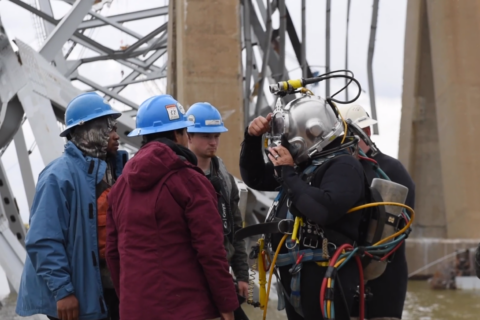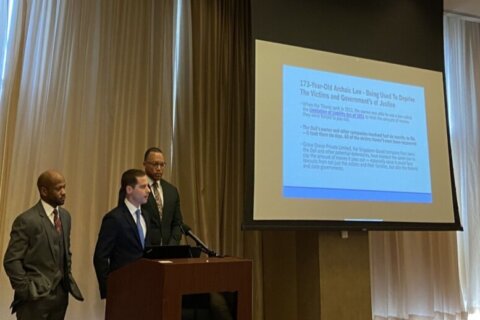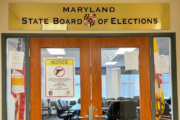This content was republished with permission from WTOP’s news partners at Maryland Matters. Sign up for Maryland Matters’ free email subscription today.
This article was republished with permission from WTOP’s news partners at Maryland Matters. Sign up for Maryland Matters’ free email subscription today.
Backers of a proposed high-speed train between Baltimore and Washington, D.C. tout the project as a boon for both cities — and the Maryland economy.
Baltimore Mayor Brandon M. Scott’s administration doesn’t see it that way.
The proposed “super-conducting magnetic levitation” — or “Maglev” — train, modeled after an existing system that opened in Japan in the 1980s, is capable of traveling at 311 miles per hour, enough to get people between the two cities in 15 minutes. It is backed by Japan Central Railroad and is currently undergoing environmental review.
In a May 14 letter to the Maryland Department of Planning, two senior members of Scott’s team urged state and federal transportation officials to reject the project.
The letter laid out a host of reasons why the project should not move forward.
Among them:
- Proposed stations — in Cherry Hill and Camden Yards — would be incompatible with existing and planned structures.
- Jurisdictions in the project’s path “would not be served by the SCMAGLEV” but they “would be subjected to the construction impacts.”
- Fear that home- and business-owners in Baltimore would suffer “property devaluation and the use of eminent domain.”
- Concern that only upper-income travelers would be able to afford the estimated $60 one-way fare.
- Northeast Maglev, the company behind the venture, hopes to eventually have a system that travels between D.C. and New York in about an hour. Because future segments have yet to be designed, Baltimore officials said, it is impossible to “evaluate the full extent of the environmental, historical, land use, and transportation impacts on the City of Baltimore.”
City officials also expressed concern that maglev would undercut existing Amtrak and MARC service, and they noted that Amtrak has just landed $2.4 billion in federal funds toward ambitious improvements along the Northeast Corridor.
“These are fully functioning and existing passenger train services along the United States’ Northeast Corridor that we fully support for future funding, transportation efficiency, safety, access, and development,” Baltimore’s planning director Chris D. Ryer and transportation chief Steve Sharkey wrote.
Their filing with the state was first reported by The Baltimore Sun.
Baltimore-Washington Rapid Rail, a sister company working in tandem with Northeast Maglev, has sought for years to build support among local, state and federal officials. (Their top lobbyist, Gerard Evans, is a seasoned Annapolis hand who is consistently among the state’s top-grossing government relations specialists.)
The Scott administration’s apparent rejection of the proposed multi-billion dollar line follows similar actions in Prince George’s. Members of the state’s congressional delegation have also been cool to the project.
In an interview, former Maryland Governor Parris N. Glendening (D), a “smart growth” advocate who advises local leaders around the world on transit-oriented development, said Maglev backers have made a number of mistakes in their efforts to build public and political support.
A former Prince George’s County Executive, Glendening called it “a personal insult” that the line would not stop in the county, even though residents would be forced to endure years of construction.
“You can’t have the second-largest county, with the largest minority population, and basically use it as a storage yard,” he said.
Glendening also called it “outrageous” that the new train would cut through federal parkland, something that has riled residents and municipal officials in northern Prince George’s.
“I don’t know who came up with that idea,” the former governor said, “but it just does not make any sense. …The whole approach makes no sense at all. The average citizen, I think, is understanding this.”
BWRR: ‘Don’t count this as dead’
Wayne Rogers, Baltimore-Washington Rapid Rail’s CEO, pushed back against the criticisms lobbed by Baltimore officials and Glendening.
He provided 60 letters that state and federal officeholders, business leaders, labor representatives, religious and civic leaders, and others have submitted to U.S. Transportation Secretary Pete Buttigieg in support of the project.
Rogers also said that the project has consistently polled well in surveys the company has commissioned. And he noted that Baltimore’s last three mayors supported Maglev.
“We believe that Baltimore does support the project,” he said in an interview.
BWRR has a meeting with Ryer scheduled for mid-July. “We think the majority of the issues they brought up can be answered directly,” Rogers said.
He also hopes to meet with Scott (D) but has yet to get on the mayor’s calendar.
A Scott spokeswoman told Maryland Matters late Thursday that he is “intrigued by the Maglev project but primarily focused on solutions to Baltimore’s acute transportation challenges. The Mayor remains committed to transit equity and ensuring residents can access reliable transportation options within city limits and across the region.”
Rogers, the former head of the Maryland Democratic Party, cautioned against reading too much into the city’s letter.
“We have a single letter from the planning department,” he said. “Don’t count this as dead yet, because it is absolutely not.”
As for concerns expressed by Prince George’s County leaders and Glendening, Rogers noted that the county’s strategic vision, Blueprint 2035, calls for “innovation, new technology and jobs.”
“So what about this [proposal] doesn’t match that?” he asked.
He also rejected the suggestion that running a train along the Baltimore-Washington Parkway constitutes an invasion of “parkland.”
“It’s probably the most deadly national park in America,” he said, a reference to the 547 accidents that occur along the road on average each year.
Former D.C. Council Member Jack Evans (no relation to lobbyist Gerard Evans) traveled on Japan’s “Maglev” system when he chaired the board that oversees bus and rail service in the capital region.
“I have enormous familiarity with how it works, how it gets done and the benefits it can bring — and it can,” Evans said.
He acknowledged that Baltimore’s decision to reject the proposal is yet another blow for a project that has struggled to overcome opposition.
“It’s hurting,” he said. “They really do need a champion who’s going to take this and run with it.”
But he said many high-profile proposals — like DC’s convention center, Nationals Park, and Metro were unpopular. “If you ever got it done, there’d be enormous support behind it,” he said.
Like Rogers, Jack Evans said that, where rail travel is concerned, the U.S. has been surpassed by countries in Asia and Europe, where “people are looking to the future of transportation… to move people quickly and safely, from one place to another, without driving cars.”
“The East Coast transportation [network] cries out for something like this.”







